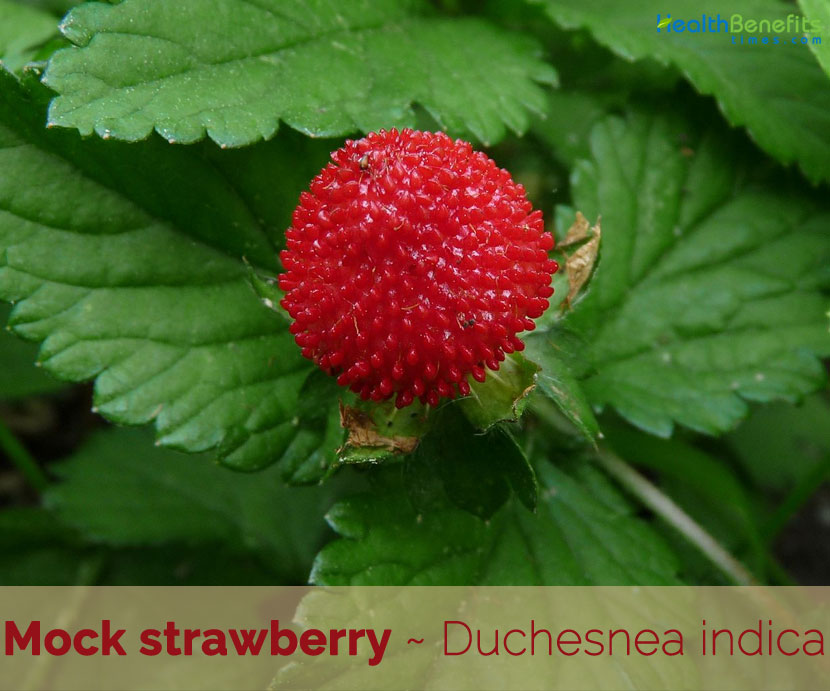| Mock Strawberry Quick Facts | |
|---|---|
| Name: | Mock Strawberry |
| Scientific Name: | Duchesnea indica |
| Origin | Indian Sub-continent, Afghanistan, China, Japan, Korea, Taiwan and south-eastern Asia |
| Colors | Green when young turning to red as they mature |
| Shapes | small round strawberry, fleshy, 0.7-1.5 cm in diameter |
| Flesh colors | Red |
| Taste | Tasteless |
| Health benefits | Beneficial for boils and abscesses, weeping eczema, ringworm, stomatitis, laryngitis, acute tonsillitis, snake and insect bites and traumatic injuries |
False strawberry, Indian strawberry, Indian mock-strawberry, mock strawberry, old-world strawberry, wild Indian strawberry, wild strawberry, yellow-flowered strawberry and rock strawberry are few of the popular common names of the plant. The fruits and leaves of mock strawberry are edible, but may not taste as delicious as true strawberries. However, the plant is used extensively as a medicinal herb, since it contains protein, iron, vitamin C and other healthy elements. Mock strawberry is regarded as a sleeper weed or minor environmental weed in some parts of New South Wales (e.g. in the wider Sydney and Blue Mountains region) and Victoria. It tends to grow in wetter sites and is sometimes found in conservation areas (e.g. it is present in the Irrawong Reserve in the Sydney region). Its fruit are readily dispersed by birds and it spreads laterally via creeping stems (i.e. stolon).
Plant Description
Mock strawberry is a low growing, fast spreading, creeping herbaceous, perennial plant that grows about 25-90 cm long. The plant is found growing in grassy slopes, ravines in low mountains, meadows, shaded woodlands, lawns, agricultural areas, natural forests, planted forests, riparian zones, disturbed and wetlands. The plant prefers wet fertile soil. The plant spreads along creeping stolons, rooting and producing crowns at each node. Root spreads horizontally and forms new roots at each node.
Leaves
Leaves are alternate, long-petiolate and trifoliate. Stipules are 4-9 mm long, herbaceous, narrowly oblong-elliptic, hairy, those of the rosette leaves fused toward the base. Petioles are 6 cm long, antrorsely pubescent. Leaf blades is 1-7 cm long, broadly ovate-triangular in outline, divided into 3 similar leaflets. These leaflets are 1.0-6.5 cm long, elliptic or ovate, rounded to more commonly pointed at the tip, rounded or narrowed to a short-stalked base. The margins are bluntly toothed or scalloped, Surfaces of the leaves are sparsely to moderately appressed-hairy, mainly along the veins.
Flowers occur solitary in the leaf axils (and among the rosette leaves), long-stalked, each with 5 bractlets beneath and alternating with the sepals, these noticeably wider than the sepals, broadly obovate, prominently 3-toothed or -lobed at the tip, becoming somewhat enlarged and reflexed at fruiting.
Flowers
Flowers are yellow, 1.2-2 cm across, on flower-stalks up to 10 cm long. Sepals are 4-7 mm long, usually arched upward, ovate-triangular, sparsely to moderately hairy, somewhat enlarged at fruiting. Petals are 5-9 mm long, narrowly obovate and yellow. Stamens are about 15-25, the anthers yellow. Pistils are numerous, densely covering the surface of the obconic expanded receptacle. Ovary is superior, glabrous, with 1 locule, with 1 ovule. Style 1 per pistil, attached laterally, shed before the fruit matures and the stigma is disc-shaped. Flowering normally takes place from March to October.
Fruits
Fertile flowers are followed by achene, in a head like cluster densely covering the surface of the enlarged expanded receptacle, but shed eventually, 0.7-1.5 cm in diameter, unequally ovate in outline, glabrous, shiny and red colored. The fruit turns red and looks like a firm small strawberry but a little rounder. The seeds are on the outer surface of the spongy fruit.
History
Mock strawberries were originally found on the Indian subcontinent, which clarifies their species name indica. They were brought over to the United States to be used as ornamental plants, because they do make for some pretty ground cover when they’re in bloom. Due to their invasive nature, they can often pop up in areas where they haven’t been planted by gardeners. Squirrels and other animals often help these plants get around by transporting their seeds to new areas. In fact, they can be found pretty much all over the United States and Canada.
Traditional uses and benefits of Mock Strawberry
- The whole plant is anticoagulant, antiseptic, depurative and febrifuge.
- It can be used in decoction or the fresh leaves can be crushed and applied externally as a poultice.
- It is used in the treatment of boils and abscesses, weeping eczema, ringworm, stomatitis, laryngitis, acute tonsillitis, snake and insect bites and traumatic injuries.
- A decoction of the plant is used as a poultice for abscesses, boils, burns etc.
- A poultice of the crushed leaves is used to treat skin ailments such as eczema.
- The fresh leaves can be crushed and applied externally as a medicinal poultice, a soft and moist mass.
- Decoction of the leaves is medicinal and used in the treatment of swellings.
- An infusion, or liquid extract, of the flowers is used to activate the blood circulation.
- The fruit of Indian Strawberry can also cure skin diseases.
- Concoction of the flowers is used to trigger blood circulation.
Other Facts
- It is a good ground cover plant, spreading quickly by means of runners.
- It is rather bare in winter though and should not be grown with small plants since it will drown them out.
- It is considered a good cover for bulbous plants.
- In folklore it is said that in India it is to be used as an offering to the gods.
References:
https://gd.eppo.int/taxon/DUCIN
https://www.itis.gov/servlet/SingleRpt/SingleRpt?search_topic=TSN&search_value=25163#null
https://pfaf.org/user/plant.aspx?latinname=Duchesnea+indica
http://www.floracatalana.net/duchesnea-indica-jacks-focke
http://www.namethatplant.net/plantdetail.shtml?plant=498
https://plants.usda.gov/core/profile?symbol=DUIN
https://en.wikipedia.org/wiki/Mock_strawberry
http://www.theplantlist.org/tpl/record/tro-27800853
http://www.flowersofindia.net/catalog/slides/Indian%20Strawberry.html
https://keyserver.lucidcentral.org/weeds/data/media/Html/potentilla_indica.htm
https://www.iewf.org/weedid/Duchesnea_indica.htm
https://indiabiodiversity.org/species/show/229606
https://davesgarden.com/guides/articles/mock-strawberries
https://www.illinoiswildflowers.info/weeds/plants/mock_strawberry.htm
https://www.bellarmine.edu/faculty/drobinson/IndianStrawberry.asp
https://davesgarden.com/guides/pf/go/2018/#b
Comments
comments
